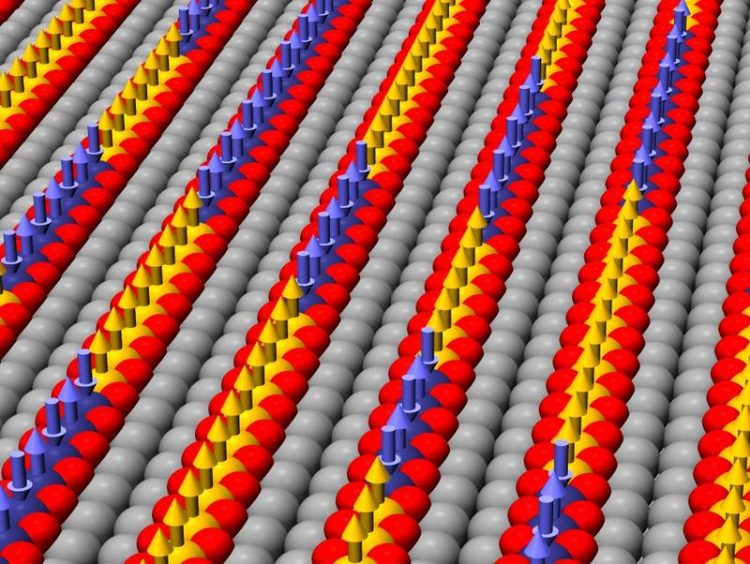Magnetic atoms arranged in neat rows

One-dimensional atom chains: the oxygen molecules (red) separate the metal atoms (yellow&blue) from the iridium substrate (grey). The arrows show the different magnetisation of the different metals. FAU/Pascal Ferstl
Nanotechnology is revolutionising the way we live by making microelectronic systems even smaller, enabling new developments in diagnosis and treatment in medicine, and giving the surfaces of materials new self-cleaning properties – to name just a few examples.
Nanostructures’ unique properties are partly due to the fact that the dimensionality of the materials is limited – such as by only allowing a crystal to grow in two directions or even just one direction instead of three. In essence, ‘one dimensional’ means arranging atoms in a chain.
‘However, an atom chain cannot exist in empty space but must be placed on a substrate,’ explains Prof. Dr. Alexander Schneider from FAU’s Chair of Solid-State Physics. ‘Doing this can cause the desired properties – magnetism in our case – to disappear again. Developing an understanding of these low-dimensional systems is a key research priority, as they are increasingly dominating the properties of magnetic data storage.’
Oxygen allows one-dimensional atom chains to form
Professor Schneider’s team collaborated with the working groups led by Prof. Dr. Klaus Heinz, also from the Chair of Solid-State Physics, and Prof. Dr. Josef Redinger from the Center for Computational Materials Science at the Vienna University of Technology. Together they were able to demonstrate that oxygen enables perfect single-atom chains to grow from manganese, iron, cobalt and nickel on an iridium surface.
‘Evaporating metals onto a metallic surface in a vacuum is a common procedure,’ Alexander Schneider says. ‘However, this often produces a two-dimensional layer of metal. For the first time, with the help of oxygen, we have managed to produce atom chains that cover the entire iridium surface, are arranged with a regular distance of 0.8 nanometres between each atom and can be up to 500 atoms long, without a single structural fault. This all happens through self assembly, i.e. the chains form without any external help.’
The physicists discovered that the oxygen atoms work like a kind of lifting mechanism that separates the atom chains from the iridium substrate. This gives the chains their one-dimensional character and their magnetic properties. The calculations made by the working group in Vienna showed that the magnetism of the metals changes in the one-dimensional structure: nickel becomes non-magnetic, cobalt remains ferromagnetic, and iron and manganese become antiferromagnetic, which means that the magnetisation direction changes with each atom.
‘What is unique about our process is that, as well as allowing perfect chains of individual materials to grow, it enables chains of alternating metal atoms to form,’ Alexander Schneider explains. ‘This means that we can create mixed systems in which ferromagnetic sections of chains can be separated from antiferromagnetic or non-magnetic sections, for example.’
Potential for new developments in basic research
The discovery of the self-assembling system of perfectly organised magnetic atom chains could lead to new developments in basic research on one-dimensional systems. In particular, further research into a system of pieces of chains with different lengths and magnetic properties will reveal which effects can be expected for increasing miniaturisation in data storage.
Another interesting aspect of the material system that the researchers studied is that, due to the oxygen built into the chains, the properties of the chains are a cross between those of a one-dimensional metal and an oxide. The perfect lateral arrangement of the chains which is preserved over long distances means that research methods that cannot be applied on the atomic scale can be used to study aspects of the atom chains such as their catalytic properties.
Media Contact
More Information:
http://www.fau.de/All latest news from the category: Physics and Astronomy
This area deals with the fundamental laws and building blocks of nature and how they interact, the properties and the behavior of matter, and research into space and time and their structures.
innovations-report provides in-depth reports and articles on subjects such as astrophysics, laser technologies, nuclear, quantum, particle and solid-state physics, nanotechnologies, planetary research and findings (Mars, Venus) and developments related to the Hubble Telescope.
Newest articles

NASA: Mystery of life’s handedness deepens
The mystery of why life uses molecules with specific orientations has deepened with a NASA-funded discovery that RNA — a key molecule thought to have potentially held the instructions for…

What are the effects of historic lithium mining on water quality?
Study reveals low levels of common contaminants but high levels of other elements in waters associated with an abandoned lithium mine. Lithium ore and mining waste from a historic lithium…

Quantum-inspired design boosts efficiency of heat-to-electricity conversion
Rice engineers take unconventional route to improving thermophotovoltaic systems. Researchers at Rice University have found a new way to improve a key element of thermophotovoltaic (TPV) systems, which convert heat…



